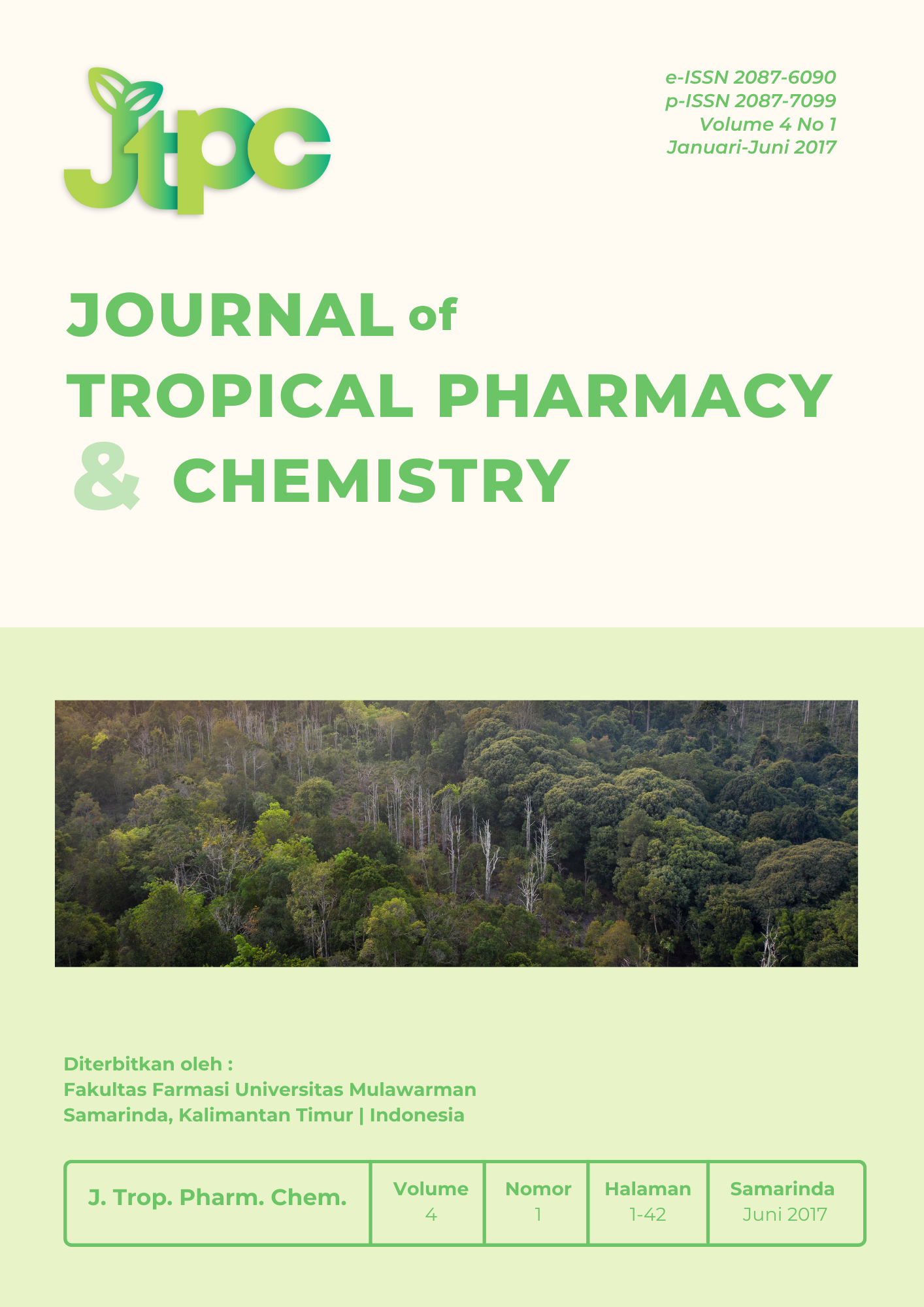The Immunosuppressant Effect Comparation Between Ethyl Acetate and n-Butanol Fractions of Kalanchoe Pinnata (Lmk) Pers In 2,6,10,14 Tetramethylpentadecane-Treated Mice
DOI:
https://doi.org/10.30872/j.trop.pharm.chem.v4i1.86Keywords:
lupus model, Kalanchoe pinnata (Lmk)Pers, flavonoids, ethyl acetate fraction, n - butanol fractionAbstract
Immunosuppressant drugs are the main treatment of lupus patient. The ACR and SLICC treatment guidelines are able to increase the quality of life, but the outcome is not satisfying since the off-label therapy of corticosteroids and cytotoxic drugs give a lot of side effects. Many breakthrough efforts still develop in order to find the safe and effective drugs for lupus, such as finding immunosuppressant drugs from natural resources. One of the potential resources is Kalanchoe pinnata (Lmk) Pers, which have immunosuppressant, anti-inflammatory, antinociceptive, and antioxidant effects. Thus, in the previous study, we found the effect of the aqueous extract of Kalanchoe pinnata (Lmk) Pers is active to repair the lupus manifestation in 2,6,10,14 tetramethylpentadecane (TMPD)-treated mice. Then, this research was focused on the in vivo immunosuppressant effect of a flavonoid-rich fraction of the extract which was consisted of the ethyl acetate (FE) and n-butanol (FB) fractions. The induction method and the extraction procedure were the same as the previous study and then the fractionation was performed by using liquid-liquid extraction. After 2-week treatment of both fractions, we obtained the differences in the total leukocytes, organ indexes, and also the spleen, kidney, and joint structure parameters. The total leukocyte of the FE group was 3,600±264 cells/mm3, which was lower than that in the FB group. The spleen and kidney indexes increased after the administration of FB fraction, while the FE fraction was not. At last, despite the histology observation of spleen resembled mild structural changes differences, the clear differences between both treatment groups occurred in the kidney and joint histology. The differences led to a conclusion that the FE fraction has the better immunosuppressant effect in TMPD-treated mice.
Downloads
References
1. Abu-Shakra M., Urowitz M.B., Gladman D.D., Gough J. 1995. Mortality studies in systemic lupus erythematosus. Results from a single center. I. Causes of death, The Journal of Rheumatology, 22(7), 1259- 1264
2. Bertoli A.M., Alarcon G.S. 2007. Epidemiology of systemic lupus erythematosus. In: Tsokos GC, Gordon C, Smolen JS. A companion to rheumatology Systemic lupus erythematosus. Philadelphia. Mosby,1-18
3. Calvani N., Satoh M., Croker B.P., Reeves W.H., And Richards H.B., 2003. Nephritogenic Autoantibodies But Absence Of Nephritis In Il-12p35–Deficient Mice With Pristane-Induced Lupus, Kidney International, (64) 897–905
4. Comte D., Karampetsou M.P., Tsokos G.C. 2015.T Cells as a Therapeutic Target in SLE, Lupus,(24), 351-363
5. Cruz E.A., Reutera S., Martina H., Dehzada N., Muzitano M., Costa S.S., Rossi-Bergmann B., Buhla R., Stassend M., Taubea C., 2012. Kalanchoe pinnata inhibits mast cell activation and prevents allergic airway Disease, Phytomedicine, (19), 115– 121
6. Danchenko N., Satia J.A., Anthony M.S. 2006. Epidemiology of systemic lupus erythematosus: a comparison of worldwide disease burden. Lupus, 15(5), 308-18
7. Ferreira RT., Coutinho MAS, CarmoMalvar D., Costa EA, Florentino IF, Costa SS and Vanderlinde FA. 2014. Mechanisms Underlying the Antinociceptive, Antiedematogenic, and Anti-Inflammatory Activity of the Main Flavonoid from Kalanchoe pinnata, Evidence-Based Complementary and Alternative Medicine Volume 2014, Article ID 429256, 8 pages
8. Grossman JM, 2009. Lupus arthritis, Best Practice & Research Clinical Rheumatology, 23; 495–506
9. Jacobsen S., Petersen J., Ullman S., Junker P., Voss A., Rasmussen J.M., et al. 1999. Mortality and causes of death of 513 Danish patients with systemic lupus erythematosus, Scandinavian Journal of Rheumatology, 28(2),75-80
10. Leiss H, Niederreiter B, Bandur T, Schwarzecker B, Blu S, Steiner G, Ulrich W, Smolen JS, Stumvoll GH.2013. Pristane-induced lupus as a model of human lupus arthritis: evolvement of autoantibodies, internal organ and joint inflammation, Lupus, (22), 778-792
11. Reeves HW, Lee PY, Weinstein JS, Satoh M, and Lu L, 2009. Induction of autoimmunity by pristane and other naturally occurring Hydrocarbons, Trends in Immunology; 30(9): 455–464
12. Rifa’i M, 2011. Protective Effect of CD4+CD25+ Regulatory T Cells on Mice Model of Rheumatoid Arthritis, Annales Bogorienses, 15(1), 1-7
13. Salido EO and Manapat HM., 2010. Epidemiology of systemic lupus erythematosus in Asia, Lupus, 19(12),1365-1373
14. Satoh M, Richards HB, Reeves WH.1999. Pathogenesis of autoantibody production and glomerulonephritis in pristane-treated mice: an inducible model of SLE. In: Tsokos GC, Kammer G, editors. Lupus: Molecular and cellular pathogenesis. Humana Press; p. 399– 416
15. Tieng AT, Sadow CA, Jay G, Putterman C. 2011. Diffuse Calcification of the Spleen: A Novel Association with Systemic Lupus Erythematosus, Seminar of Artheritis and Rheumatology (41); 187-193




